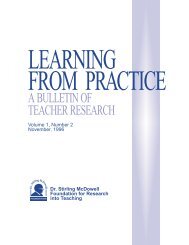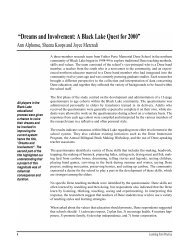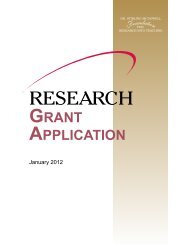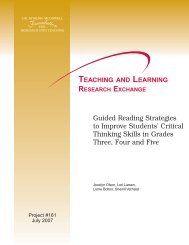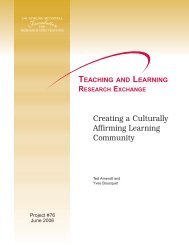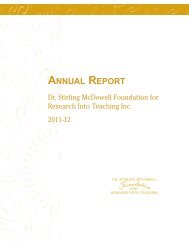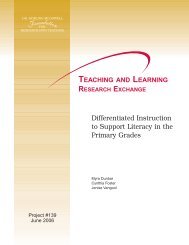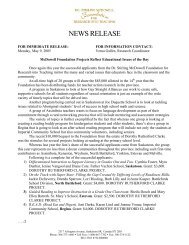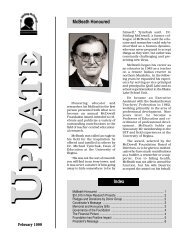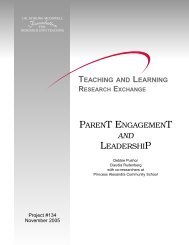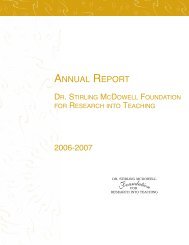Report - Dr. Stirling McDowell Foundation for Research Into Teaching
Report - Dr. Stirling McDowell Foundation for Research Into Teaching
Report - Dr. Stirling McDowell Foundation for Research Into Teaching
You also want an ePaper? Increase the reach of your titles
YUMPU automatically turns print PDFs into web optimized ePapers that Google loves.
TEACHING AND LEARNING<br />
RESEARCH EXCHANGE<br />
A School-Based Study on<br />
the Relationship Between<br />
Increased Literacy Levels<br />
and School Attachment<br />
Shaun McEachern<br />
Project #162<br />
February 2008
This research was partially funded through a grant from the <strong>McDowell</strong> <strong>Foundation</strong>. However, the points of view<br />
and opinions expressed in project documents are those of the authors and do not necessarily reflect the views<br />
of the <strong>Foundation</strong>.<br />
The purpose of the <strong>Dr</strong>. <strong>Stirling</strong> <strong>McDowell</strong> <strong>Foundation</strong> <strong>for</strong> <strong>Research</strong> into <strong>Teaching</strong> is to fund research, inquiry and<br />
dissemination of in<strong>for</strong>mation focusing on instruction (both teaching and learning) in the context of the public<br />
elementary and secondary education system. Specifically, it will:<br />
1) contribute to knowledge about teaching and learning;<br />
2) encourage educational inquiry through a wide range of methodologies;<br />
3) support the involvement of practising teachers in active research projects;<br />
4) encourage organizations as well as individuals to determine and act in areas of research and inquiry; and<br />
5) encourage experimentation with innovative ideas and methodologies related to teaching and learning.<br />
The <strong>Foundation</strong> is an independent charitable organization <strong>for</strong>med by the Saskatchewan Teachers’ Federation<br />
in 1991. It is governed by a Board of Directors with the assistance of an Advisory Committee of representatives<br />
from the educational and business communities. The selection and evaluation of projects funded by the<br />
<strong>Foundation</strong> is carried out by a teacher-led Project Review Committee. Inquiries concerning research supported<br />
by the <strong>McDowell</strong> <strong>Foundation</strong> may be directed to the following address:<br />
<strong>Research</strong> Coordinator<br />
<strong>Dr</strong>. <strong>Stirling</strong> <strong>McDowell</strong> <strong>Foundation</strong><br />
2317 Arlington Avenue<br />
Saskatoon SK S7J 2H8<br />
Telephone: 1-800-667-7762 or (306) 373-1660<br />
© 2008 by the <strong>Dr</strong>. <strong>Stirling</strong> <strong>McDowell</strong> <strong>Foundation</strong> <strong>for</strong> <strong>Research</strong> into <strong>Teaching</strong> Inc. Permission is given to use this<br />
work <strong>for</strong> educational purposes, except that authorization from the original source must be obtained <strong>for</strong> the use<br />
of any material that appears in the work with credit to another source.
Table of Contents<br />
Acknowledgements.....................................................................................ii<br />
Our <strong>Research</strong> Question..............................................................................1<br />
Our School Community..............................................................................1<br />
Getting Started ..........................................................................................2<br />
The Literacy Classroom ..............................................................................2<br />
Action <strong>Research</strong>.........................................................................................3<br />
Challenges ................................................................................................3<br />
Sharing Our Progress.................................................................................4<br />
Conclusions ..............................................................................................5<br />
The Future................................................................................................6<br />
References ................................................................................................7<br />
Appendices<br />
A. “Tell Them From Me” Survey Data, Snapshots from<br />
November, 2006 and May, 2007 ......................................................9<br />
B. “Tell Them From Me”.....................................................................12<br />
RESEARCH REPORT: A School-Based Study on the Relationship Between Increased Literacy Levels and School Attachment<br />
i
Acknowledgements<br />
We wish to thank the <strong>McDowell</strong> <strong>Foundation</strong> <strong>for</strong> approving our research grant and<br />
<strong>for</strong> their encouragement as we explored the effects increased literacy levels had on<br />
our students’ attachment to their school.<br />
We would also like to thank the support staff at Tell Them From Me <strong>for</strong> their<br />
patience, guidance and professionalism over the past year while we utilized their<br />
on-line survey.<br />
The Mount Royal School Attachment <strong>Research</strong> Team:<br />
Mrs. Fay Elke<br />
Mr. Shaun McEachern<br />
ii<br />
RESEARCH REPORT: A School-Based Study on the Relationship Between Increased Literacy Levels and School Attachment
Our <strong>Research</strong> Question<br />
Does an increase in literacy levels, <strong>for</strong> students classified as struggling<br />
readers, also result in increased feelings of school attachment?<br />
For the purpose of our study we defined school attachment as a “sense of<br />
belonging at school, a network of relationships with peers as well as other school<br />
personnel and a sense of the inherent value <strong>for</strong> the learning process as it relates<br />
to students’ lives (Dworkin, 1987; Goodenow, 1991).<br />
Our School Community<br />
Mount Royal Collegiate was built in 1965 and is a part of the Saskatoon Public<br />
School Division. MRCI is home to an eclectic body of students that represents<br />
much of the diversity found in the city of Saskatoon.<br />
A wide variety of courses are offered to the more than fifteen hundred students who<br />
attend MRCI. Beyond the core academic subjects that are offered, students may<br />
also enrol in any one of the numerous technology or fine arts classes. Mount Royal<br />
Collegiate is also home to an array of special programs created to meet the<br />
needs of our diverse student body.<br />
RESEARCH REPORT: A School-Based Study on the Relationship Between Increased Literacy Levels and School Attachment<br />
1
Getting Started<br />
In the fall of 2005 teachers, guidance counsellors, administrators and parents<br />
referred students <strong>for</strong> the newly created Literacy 10/20 courses that were being<br />
offered at MRCI. The goal of the Literacy classroom was to improve student<br />
comprehension of text through daily explicit instruction and promote life-long<br />
learning. In more colloquial terms, we also hoped to turn non-readers into<br />
readers. Once the students registered and classes began, each individual student<br />
was put through a series of pre- and post-tests to determine the student’s<br />
abilities and identify areas of needed intervention. The diagnostic that was used<br />
was the Gray Oral Reading Test.<br />
The results of the GORT pre-tests were both fascinating and depressing. Of the<br />
students referred, 97% fit the category of “dependent, struggling readers” since they<br />
all read, at the very least, three grade levels below their age in the areas of<br />
fluency, comprehension, accuracy and rate.<br />
The Literacy Classroom<br />
As the teacher of Literacy 10/20, I sat down and tried to decide in what direction<br />
to take my students and, in essence, where to begin. The words of K. E Stanovich<br />
echoed in my mind: “[A]s the developmental process continues, young struggling<br />
readers become older struggling readers, and the achievement gap widens”<br />
(Stanovich, 1986, p.30).<br />
The actual structure of the literacy classroom was guided by the principles and<br />
theories offered by numerous literacy experts. Students were introduced, through<br />
teacher-modelled explicit instruction, to a wide variety of reading comprehension<br />
strategies (Durkin, 1978; Duffy, 2003; Pressley, 1995; Beers, 2003). A strong<br />
emphasis was also placed on vocabulary development (Ehri, 1999; Calhoun,<br />
1999), fluency (Adams, 1990; Stanovich, 1986), and writing (Tankersley, 2005), and<br />
time was allotted each day <strong>for</strong> a wide variety of reading experiences at the<br />
developed level.<br />
After two semesters the students were then post-tested using the Grey Oral<br />
Reading Test to see if any growth had occurred in the areas of fluency,<br />
comprehension and accuracy. To our delight, all of the students saw some<br />
growth, and some of this growth was substantial, especially in the areas of<br />
fluency and comprehension.<br />
2 RESEARCH REPORT: A School-Based Study on the Relationship Between Increased Literacy Levels and School Attachment
Action <strong>Research</strong><br />
After analyzing the GORT scores, we then decided to research and analyze how<br />
these improved literacy scores may affect the attachment of Literacy 10/20<br />
students to their school. One of the main objectives in offering the Literacy<br />
classes to secondary students classified as “dependent readers,” was not only the<br />
improvement of comprehension but the hope that improved literacy skills would<br />
result in a more positive attitude towards academia. With this in mind, our<br />
next step was to contact the people from “Tell Them From Me,” an on-line survey<br />
company recommended by our school division, and get the students enrolled. The<br />
Tell Them From assessment system was developed in 2004 and “aimed to<br />
provide leading indicators of student engagement and wellness, and classroom and<br />
school climate” (Flanagan, 2007). The “Tell Them From Me” survey focused on and<br />
assessed “16 student outcomes pertaining to student engagement and wellness and<br />
15 aspects of classroom and school learning climate that are known to affect<br />
learning outcomes” (Flanagan, 2007).<br />
The survey was taken twice by more than twenty-five literacy students, once in the<br />
fall and once again in late May. The survey was to take approximately thirty<br />
minutes each time and the in<strong>for</strong>mation gathered was to be both tenable and<br />
transparent.<br />
Challenges<br />
To say that we had a few obstacles and challenges to overcome during the<br />
course of our study would be a far too blithe description of our experiences. Our<br />
first <strong>for</strong>midable challenge occurred when many of the students could not<br />
comprehend the questions provided in the survey. We tried to circulate around the<br />
room as much as possible and translate the questions <strong>for</strong> the students, but it was<br />
a prodigious task to be in three places at once. This, of course, made the taking<br />
of the survey much more difficult than was originally anticipated.<br />
At least half of the students openly admitted that they had trouble discerning any<br />
meaning in the questions. Ten of the students required continual teacher<br />
interpretation of the questions and only six students, all of whom were reading<br />
above a grade eight level but well below their current grade standing, found the<br />
survey questions “fairly easy” to understand. This being said, the survey took much<br />
longer than the initial time allotment of thirty minutes.<br />
Taking the survey also caused an enormous amount of consternation <strong>for</strong> some<br />
students who did not want to be put through the process again a second time in<br />
May. It was obvious that in order to alleviate the students’ pejorative feelings about<br />
the study, class time had to be used to go over the questions and discuss their<br />
meaning. In the end the students were far more prepared <strong>for</strong> the second round of<br />
questioning than they were <strong>for</strong> the first. This difference in level of preparation, along<br />
with many other factors, undoubtedly played a part in skewing much of the data<br />
that we were able to collect from the survey.<br />
RESEARCH REPORT: A School-Based Study on the Relationship Between Increased Literacy Levels and School Attachment<br />
3
Sharing Our Progress<br />
“Tell Them From Me” eventually provided us with the findings from the survey in<br />
the <strong>for</strong>m of numerous bar graphs (see the appendices). As stated earlier, “Snapshot<br />
1” presented in Appendix A represented the in<strong>for</strong>mation gathered in September,<br />
and “Snapshot 2” presented in Appendix B represented the in<strong>for</strong>mation gathered<br />
in May.<br />
In each “Tell Them From Me” survey, students provided feedback <strong>for</strong> eleven<br />
different perspectives or categories, all related to school attachment. These<br />
categories included, but were not limited to:<br />
1. sense of belonging,<br />
2. value school outcomes,<br />
3. expectations of finishing high school,<br />
4. expectations of going to university,<br />
5. truancy rate,<br />
6. participation in school sports and clubs,<br />
7. hours per day spent on homework and reading, and<br />
8. hours per day spent watching TV and video games.<br />
The results of the study were both disheartening and puzzling. The survey<br />
recognized a decrease in the students’ attachment to school in almost every<br />
area from a sense of belonging, to value school outcomes, to aspirations of<br />
finishing high school and rates of truancy. However, there was, surprisingly, a<br />
precipitous increase in students’ aspirations to go to university and their<br />
participation in school activities.<br />
The students also indicated that their truancy rates had increased from semester<br />
one to semester two. This in<strong>for</strong>mation was in stark contrast to the actual<br />
attendance records found in our school’s data base. The attendance of the<br />
majority of the students <strong>for</strong> the Literacy class was nearly exemplary, and the<br />
students’ attendance at school as a whole made us feel far more sanguine than the<br />
in<strong>for</strong>mation the students provided in the survey.<br />
The most disappointing aspect of the survey, <strong>for</strong> us, was the students’ responses<br />
to the question posed about finishing high school. When the students first<br />
answered this question in the fall, 92% felt they would complete high school. When<br />
the same question was posed again in May, only 73% saw the completion of high<br />
school as a realistic goal. Un<strong>for</strong>tunately, due to the structure of the “Tell Them<br />
From Me” survey, we were not able to move beyond the cursory to a more<br />
comprehensive understanding of why the students experienced such a dramatic<br />
shift in their future academic aspirations. We were inclined to believe however, that<br />
posing these questions in May, towards the end of the school year, and to<br />
students who have struggled academically <strong>for</strong> most of their educational lives, may<br />
have adversely affected the data.<br />
4 RESEARCH REPORT: A School-Based Study on the Relationship Between Increased Literacy Levels and School Attachment
Conclusions<br />
If we were to use the in<strong>for</strong>mation gathered from the survey as our only source of<br />
data, then the answer to our question about whether increased literacy levels result<br />
in an increase in school attachment would be an emphatic no. Fortunately or<br />
un<strong>for</strong>tunately, the evidence provided by the survey is far too amorphous to<br />
come to this kind of definitive conclusion.<br />
In January of 2008 I returned to MRCI to interview many of these students as part<br />
of my graduate work. Of the 20 students I wished to interview, all of whom were<br />
involved in the attachment study, 18 were still in school and all of them talked<br />
about graduating either this year or next. Many of the students were playing sports<br />
or belonged to clubs, and most admitted that they were enjoying their school year.<br />
Some even talked about their post-secondary aspirations. The in<strong>for</strong>mation they<br />
shared in our conversations was in many ways the antithesis of the in<strong>for</strong>mation<br />
outlined in the “Tell Them From Me” survey.<br />
If we were to conduct the study again we would obviously do things differently.<br />
Although there are many positive aspects in the “Tell Them From Me” survey, it did<br />
not, in our opinion, meet the needs of our students. For some, it was far too<br />
difficult to understand; <strong>for</strong> others, its attention to detail was far too pedantic. The<br />
students’ answers to the survey questions often contradicted their actions, and the<br />
fact that we gave the survey questions to them so late in the year the second time<br />
probably affected the outcomes.<br />
In hindsight it would have been prudent and prescient to include some secondary<br />
diagnostic instrument or method to go along with the data we collected from the<br />
survey but, as is often the case, we tend to learn best from our own mistakes.<br />
RESEARCH REPORT: A School-Based Study on the Relationship Between Increased Literacy Levels and School Attachment<br />
5
The Future<br />
Our school division has launched a three- to six-year Literacy For Life initiative that<br />
has proven to be not only successful, but also groundbreaking. We have been able<br />
to access professional development in our own city and have the support of<br />
superintendents, coordinators, consultants and administrators at every level. It is<br />
our hope that every collegiate is able to maintain a viable literacy component and<br />
that all schools, elementary and secondary alike, continue on their auspicious<br />
journey towards increased literacy levels <strong>for</strong> all students in the Saskatoon Public<br />
School Division.<br />
One of the drawbacks to this study was its inability to fully measure the students’<br />
long-term growth and perceptions about school. For many students who have<br />
struggled with reading <strong>for</strong> most of their academic lives, a year, or even two<br />
years, of being immersed in a literacy rich environment may not be enough to<br />
overcome a deeply rooted belief system. It would be interesting to talk with these<br />
students again in three or four years to see if their perceptions about reading and<br />
learning were affected in any way by their experiences in the Literacy classroom.<br />
6 RESEARCH REPORT: A School-Based Study on the Relationship Between Increased Literacy Levels and School Attachment
References<br />
Adams, M.J. (1990). Beginning to Read: Thinking & Learning About Print.<br />
Cambridge, MA: The MIT Press.<br />
Allington, R. (2001). What Really Matters <strong>for</strong> Struggling Readers. New York:<br />
Addison-Wesley Educational Publishers.<br />
Beers, Kylene (2003). When Kids Can’t Read, What Teachers Can Do: A Guide <strong>for</strong><br />
Teachers 6-12. Portsmouth, NH: Heinemann.<br />
Brown, A. L., & Palincsar, A.S. (1985). Reciprocal <strong>Teaching</strong> of Comprehension<br />
Strategies: A Natural History of One Program to Enhance Learning. Urbana, IL:<br />
University of Illinois.<br />
Calhoun, F. Emily (1999). <strong>Teaching</strong> Beginning Reading and Writing with PWIM.<br />
Association <strong>for</strong> Supervision and Curriculum Development: Virginia, USA<br />
Duffy, Gerald D. (2003). Explaining Reading: A Resource <strong>for</strong> <strong>Teaching</strong> Concepts,<br />
Skills, and Strategies. Guil<strong>for</strong>d Press: New Portland, MA.<br />
Durkin, D. (1978). What Classroom Observatins Reveal About Reading<br />
Comprehension Instruction. Reading <strong>Research</strong> Quarterly, 14(4), 481-488.<br />
Dworkin, A. (1987). Teacher Burnout in the Public Schools. New York Press:<br />
Albany State University.<br />
Ehri, L. C. (1999). Phases of Acquisition in Learning to Read Words and Instructional<br />
Implications. Paper presented to the Annual Meeting of the American Medical<br />
<strong>Research</strong> Association, Montreal.<br />
Feather, Elizabeth & Brown, David (2005). A high frequency word list <strong>for</strong> teaching<br />
adult beginning readers. Reading Improvement. Fall, 2005 Vol. 42, Issue 3.<br />
Flanagan, Patrick (2007). Canadian Students: Tell Them From Me. Education<br />
Canada. Summer, 2007, Vol. 47: 46-50<br />
Flood, James, Dianne Lapp & James Squire. (2003). Handbook of <strong>Research</strong> on<br />
<strong>Teaching</strong> the English Language Arts. Lawrence Erlbaum & Associates: Mahwah,<br />
New Jersey<br />
Gillet, J. W., & C. Temple. (1990). Understanding Reading Problems: Assessment<br />
and Instruction, 3rd. edition. New York: Longman.<br />
Goodenow, C. (1991). The sense of belonging and its relationship to academic<br />
motivation among pre and early adolescent students. American Educational<br />
<strong>Research</strong> Association.<br />
Harvey, Stephanie & Anne Goudvis (2000). Strategies that Work: <strong>Teaching</strong><br />
Comprehension to Enhance Understanding. York, MA: Stenhouse Publishers.<br />
RESEARCH REPORT: A School-Based Study on the Relationship Between Increased Literacy Levels and School Attachment<br />
7
He, A. E. (1999). A comparison of two types of school attachment <strong>for</strong> teacher<br />
educators.<br />
Joyce, Bruce & Marsha Weil. (2005). Models of <strong>Teaching</strong>. Boston, MA: Pearson<br />
Publishers.<br />
Libbey, H. P. (2004). Measuring student relationships to school: Attachment,<br />
bonding, connectedness, and engagement. The Journal of School Health,<br />
74(7): 274<br />
McEwen, Elaine. (2003). Seven Strategies of Highly Effective Readers. Thousand<br />
Oaks, CA: Corwin Press.<br />
McGill- Franzen, A. & R. Allington. (1991). The Gridlock of Low Achievement.<br />
Remedial and Special Education, 12: 20-30.<br />
Mouton, S. G. (1996). School attachment: Perspectives of low-attached high<br />
school students. Educational Psychology, 16(3): 297<br />
Pressley, M. (1995). Cognitive Strategy Instruction that Really Improves Student<br />
Per<strong>for</strong>mance. Cambridge, MA: Brookline.<br />
Samuels, Jay & Alan Farstrup. (1992). What <strong>Research</strong> Has to Say about Reading<br />
Instruction. Newark, Delaware: International Reading Association.<br />
Shippen, M. E., D. E. Houchins & C. Steventon. (2003) Reading assessment<br />
and instruction <strong>for</strong> students at risk. Special Education <strong>for</strong> All Teachers. 3rd<br />
Edition. Dubuque, IA: Kendall Hunt, pp. 275-311.<br />
Somers, C. L. (2001). Predicting adolescents’ risky behaviors: The influence of future<br />
orientation, school involvement, and school attachment. Adolescent Family<br />
Health, 2(1): 3.<br />
Stanovich, K. E. (1986). Matthew effects in reading. Reading <strong>Research</strong> Quarterly,<br />
Vol. 2: 360-407.<br />
Tankersley, Karen. (2005). Literacy Strategies <strong>for</strong> Grades 4-12. Alexandria, Virginia:<br />
ASCD.<br />
Tompkins, Gail E. (1998). 50 Literacy Strategies: Step By Step. Upper Saddle<br />
River, NJ: Merrill-Prentice Hall.<br />
Tovani, Cris. (2000). I Read It, But I Don’t Get It: Comprehension Strategies <strong>for</strong><br />
Adolescent Readers. Portland, MA: Stenhouse Publishers.<br />
Vygotsky, Lev. (1992). Thought and Learning. Cambridge, MA: MIT Press.<br />
8 RESEARCH REPORT: A School-Based Study on the Relationship Between Increased Literacy Levels and School Attachment
Appendix A<br />
10<br />
9<br />
8<br />
7<br />
6<br />
5<br />
4<br />
3<br />
2<br />
1<br />
0<br />
Reproduced with permission from The Learning Bar (www.thelearningbar.com)<br />
RESEARCH REPORT: A School-Based Study on the Relationship Between Increased Literacy Levels and School Attachment<br />
9
10<br />
9<br />
8<br />
7<br />
6<br />
5<br />
4<br />
3<br />
2<br />
1<br />
0<br />
Reproduced with permission from The Learning Bar (www.thelearningbar.com)<br />
10<br />
9<br />
8<br />
7<br />
6<br />
5<br />
4<br />
3<br />
2<br />
1<br />
0<br />
Reproduced with permission from The Learning Bar (www.thelearningbar.com)<br />
10 RESEARCH REPORT: A School-Based Study on the Relationship Between Increased Literacy Levels and School Attachment
10<br />
9<br />
8<br />
7<br />
6<br />
5<br />
4<br />
3<br />
2<br />
1<br />
0<br />
Reproduced with permission from The Learning Bar (www.thelearningbar.com)<br />
10<br />
9<br />
8<br />
7<br />
6<br />
5<br />
4<br />
3<br />
2<br />
1<br />
0<br />
Reproduced with permission from The Learning Bar (www.thelearningbar.com)<br />
RESEARCH REPORT: A School-Based Study on the Relationship Between Increased Literacy Levels and School Attachment<br />
11
Appendix B<br />
100<br />
90<br />
80<br />
70<br />
60<br />
50<br />
40<br />
30<br />
20<br />
10<br />
0<br />
Reproduced with permission from The Learning Bar (www.thelearningbar.com)<br />
12 RESEARCH REPORT: A School-Based Study on the Relationship Between Increased Literacy Levels and School Attachment
100<br />
90<br />
80<br />
70<br />
60<br />
50<br />
40<br />
30<br />
20<br />
10<br />
0<br />
Reproduced with permission from The Learning Bar (www.thelearningbar.com)<br />
100<br />
95<br />
90<br />
85<br />
80<br />
75<br />
70<br />
65<br />
60<br />
55<br />
50<br />
Reproduced with permission from The Learning Bar (www.thelearningbar.com)<br />
RESEARCH REPORT: A School-Based Study on the Relationship Between Increased Literacy Levels and School Attachment<br />
13
100<br />
90<br />
80<br />
70<br />
60<br />
50<br />
40<br />
30<br />
20<br />
10<br />
0<br />
Reproduced with permission from The Learning Bar (www.thelearningbar.com)<br />
100<br />
90<br />
80<br />
70<br />
60<br />
50<br />
40<br />
30<br />
20<br />
10<br />
0<br />
Reproduced with permission from The Learning Bar (www.thelearningbar.com)<br />
14 RESEARCH REPORT: A School-Based Study on the Relationship Between Increased Literacy Levels and School Attachment
100<br />
90<br />
80<br />
70<br />
60<br />
50<br />
40<br />
30<br />
20<br />
10<br />
0<br />
Reproduced with permission from The Learning Bar (www.thelearningbar.com)<br />
100<br />
90<br />
80<br />
70<br />
60<br />
50<br />
40<br />
30<br />
20<br />
10<br />
0<br />
Reproduced with permission from The Learning Bar (www.thelearningbar.com)<br />
RESEARCH REPORT: A School-Based Study on the Relationship Between Increased Literacy Levels and School Attachment<br />
15
5<br />
4.5<br />
4<br />
3.5<br />
3<br />
2.5<br />
2<br />
1.5<br />
1<br />
0.5<br />
0<br />
Reproduced with permission from The Learning Bar (www.thelearningbar.com)<br />
5<br />
4.5<br />
4<br />
3.5<br />
3<br />
2.5<br />
2<br />
1.5<br />
1<br />
0.5<br />
0<br />
Reproduced with permission from The Learning Bar (www.thelearningbar.com)<br />
16 RESEARCH REPORT: A School-Based Study on the Relationship Between Increased Literacy Levels and School Attachment
6<br />
5.5<br />
5<br />
4.5<br />
4<br />
3.5<br />
3<br />
2.5<br />
2<br />
1.5<br />
1<br />
0.5<br />
0<br />
Reproduced with permission from The Learning Bar (www.thelearningbar.com)<br />
6<br />
5.5<br />
5<br />
4.5<br />
4<br />
3.5<br />
3<br />
2.5<br />
2<br />
1.5<br />
1<br />
0.5<br />
0<br />
Reproduced with permission from The Learning Bar (www.thelearningbar.com)<br />
RESEARCH REPORT: A School-Based Study on the Relationship Between Increased Literacy Levels and School Attachment<br />
17
18 RESEARCH REPORT: A School-Based Study on the Relationship Between Increased Literacy Levels and School Attachment
2317 Arlington Avenue<br />
Saskatoon SK Canada S7J 2H8<br />
Phone: 306-373-1660<br />
Toll Free: 1-800-667-7762<br />
Fax: 306-374-1122<br />
E-mail: mcdowell@stf.sk.ca<br />
www.mcdowellfoundation.ca



